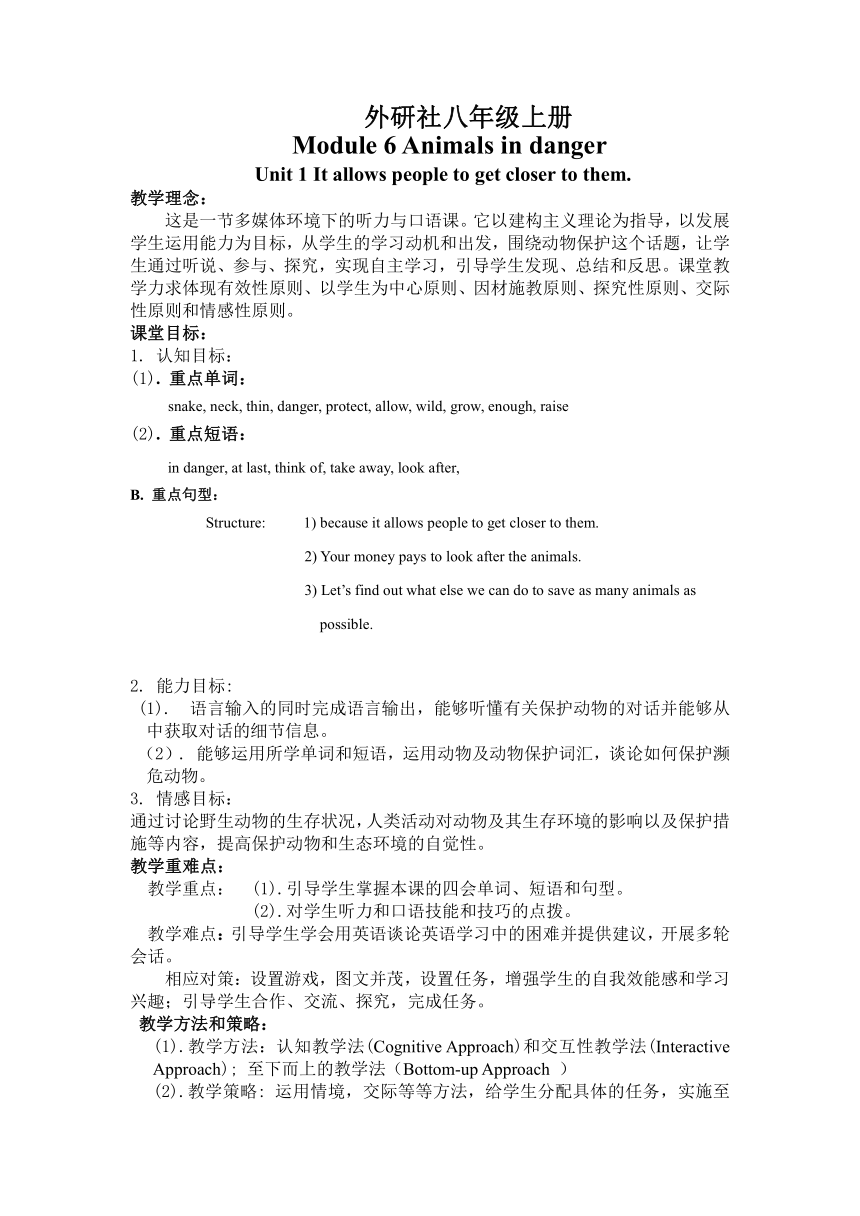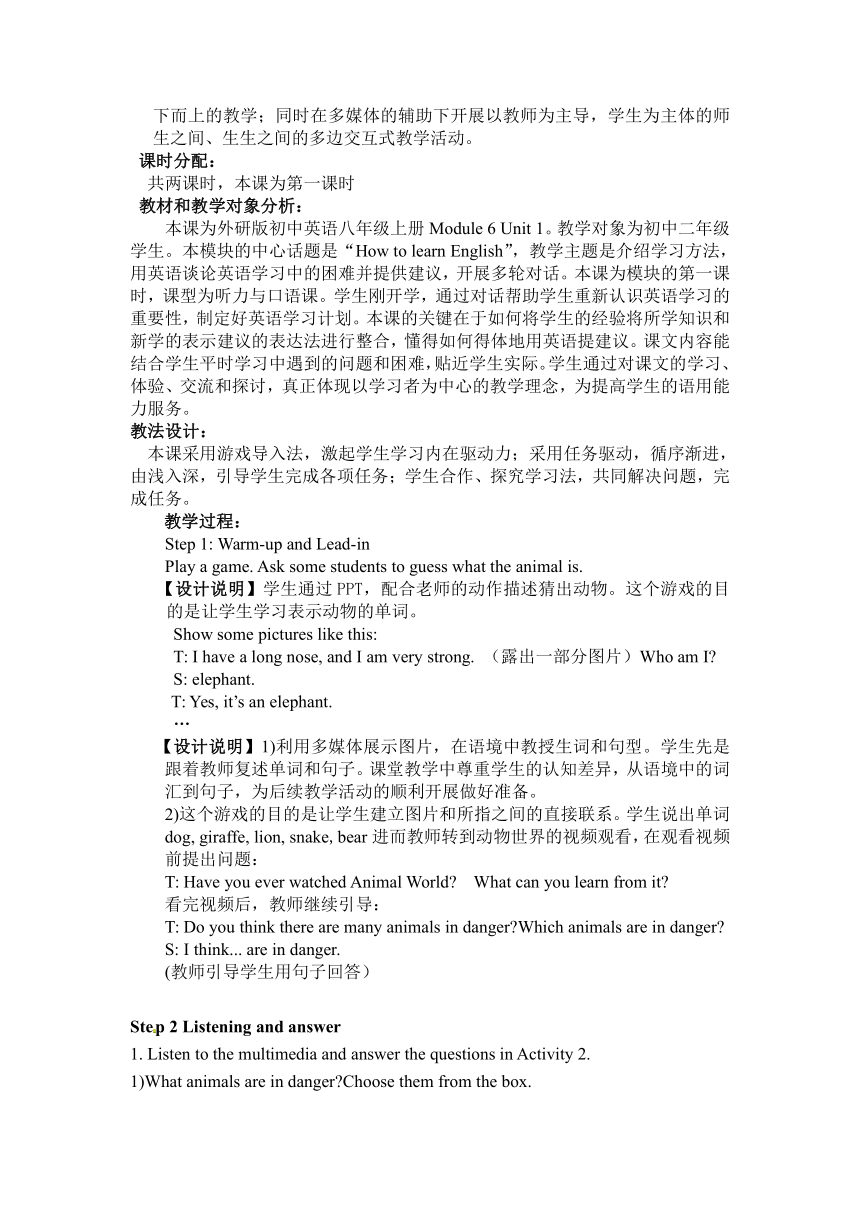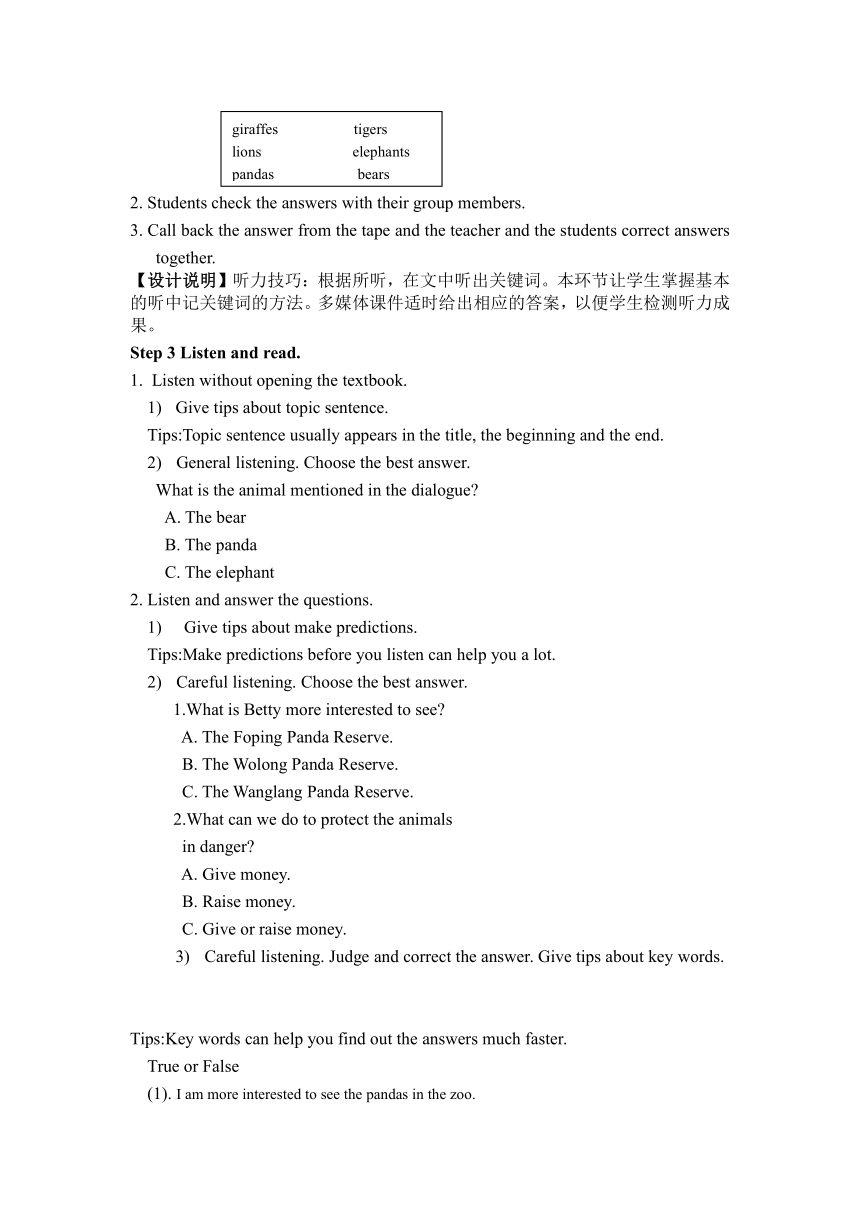外研版英语八年级上册Module6 Unit1 Animals in danger教案
文档属性
| 名称 | 外研版英语八年级上册Module6 Unit1 Animals in danger教案 |  | |
| 格式 | doc | ||
| 文件大小 | 92.5KB | ||
| 资源类型 | 教案 | ||
| 版本资源 | 外研版 | ||
| 科目 | 英语 | ||
| 更新时间 | 2024-10-17 12:22:31 | ||
图片预览



文档简介
外研社八年级上册
Module 6 Animals in danger
Unit 1 It allows people to get closer to them.
教学理念:
这是一节多媒体环境下的听力与口语课。它以建构主义理论为指导,以发展学生运用能力为目标,从学生的学习动机和出发,围绕动物保护这个话题,让学生通过听说、参与、探究,实现自主学习,引导学生发现、总结和反思。课堂教学力求体现有效性原则、以学生为中心原则、因材施教原则、探究性原则、交际性原则和情感性原则。
课堂目标:
1. 认知目标:
(1). 重点单词:
snake, neck, thin, danger, protect, allow, wild, grow, enough, raise
(2). 重点短语:
in danger, at last, think of, take away, look after,
B. 重点句型:
Structure: 1) because it allows people to get closer to them.
2) Your money pays to look after the animals.
3) Let’s find out what else we can do to save as many animals as possible.
2. 能力目标:
(1). 语言输入的同时完成语言输出,能够听懂有关保护动物的对话并能够从中获取对话的细节信息。
(2). 能够运用所学单词和短语,运用动物及动物保护词汇,谈论如何保护濒危动物。
3. 情感目标:
通过讨论野生动物的生存状况,人类活动对动物及其生存环境的影响以及保护措施等内容,提高保护动物和生态环境的自觉性。
教学重难点:
教学重点: (1).引导学生掌握本课的四会单词、短语和句型。
(2).对学生听力和口语技能和技巧的点拨。
教学难点:引导学生学会用英语谈论英语学习中的困难并提供建议,开展多轮 会话。
相应对策:设置游戏,图文并茂,设置任务,增强学生的自我效能感和学习兴趣;引导学生合作、交流、探究,完成任务。
教学方法和策略:
(1).教学方法:认知教学法(Cognitive Approach)和交互性教学法(Interactive Approach); 至下而上的教学法(Bottom-up Approach )
(2).教学策略: 运用情境,交际等等方法,给学生分配具体的任务,实施至下而上的教学;同时在多媒体的辅助下开展以教师为主导,学生为主体的师生之间、生生之间的多边交互式教学活动。
课时分配:
共两课时,本课为第一课时
教材和教学对象分析:
本课为外研版初中英语八年级上册Module 6 Unit 1。教学对象为初中二年级学生。本模块的中心话题是“How to learn English”,教学主题是介绍学习方法,用英语谈论英语学习中的困难并提供建议,开展多轮对话。本课为模块的第一课时,课型为听力与口语课。学生刚开学,通过对话帮助学生重新认识英语学习的重要性,制定好英语学习计划。本课的关键在于如何将学生的经验将所学知识和新学的表示建议的表达法进行整合,懂得如何得体地用英语提建议。课文内容能结合学生平时学习中遇到的问题和困难,贴近学生实际。学生通过对课文的学习、体验、交流和探讨,真正体现以学习者为中心的教学理念,为提高学生的语用能力服务。
教法设计:
本课采用游戏导入法,激起学生学习内在驱动力;采用任务驱动,循序渐进,由浅入深,引导学生完成各项任务;学生合作、探究学习法,共同解决问题,完成任务。
教学过程:
Step 1: Warm-up and Lead-in
Play a game. Ask some students to guess what the animal is.
【设计说明】学生通过PPT,配合老师的动作描述猜出动物。这个游戏的目的是让学生学习表示动物的单词。
Show some pictures like this:
T: I have a long nose, and I am very strong. (露出一部分图片)Who am I
S: elephant.
T: Yes, it’s an elephant.
…
【设计说明】1)利用多媒体展示图片,在语境中教授生词和句型。学生先是跟着教师复述单词和句子。课堂教学中尊重学生的认知差异,从语境中的词汇到句子,为后续教学活动的顺利开展做好准备。
2)这个游戏的目的是让学生建立图片和所指之间的直接联系。学生说出单词
dog, giraffe, lion, snake,bear进而教师转到动物世界的视频观看,在观看视频前提出问题:
T: Have you ever watched Animal World What can you learn from it
看完视频后,教师继续引导:
T: Do you think there are many animals in danger Which animals are in danger
S: I think... are in danger.
(教师引导学生用句子回答)
Step 2 Listening and answer
1. Listen to the multimedia and answer the questions in Activity 2.
1)What animals are in danger Choose them from the box.
2. Students check the answers with their group members.
3. Call back the answer from the tape and the teacher and the students correct answers together.
【设计说明】听力技巧:根据所听,在文中听出关键词。本环节让学生掌握基本的听中记关键词的方法。多媒体课件适时给出相应的答案,以便学生检测听力成果。
Step 3 Listen and read.
1. Listen without opening the textbook.
1) Give tips about topic sentence.
Tips:Topic sentence usually appears in the title, the beginning and the end.
2) General listening. Choose the best answer.
What is the animal mentioned in the dialogue
A. The bear
B. The panda
C. The elephant
2. Listen and answer the questions.
1) Give tips about make predictions.
Tips:Make predictions before you listen can help you a lot.
2) Careful listening. Choose the best answer.
1.What is Betty more interested to see
A. The Foping Panda Reserve.
B. The Wolong Panda Reserve.
C. The Wanglang Panda Reserve.
2.What can we do to protect the animals
in danger
A. Give money.
B. Raise money.
C. Give or raise money.
3) Careful listening. Judge and correct the answer. Give tips about key words.
Tips:Key words can help you find out the answers much faster.
True or False
(1). I am more interested to see the pandas in the zoo.
(2). Many wild animals have a safe place to live.
(3). Villages and farms are growing bigger and are taking away animals land and forests.
(4). There isn’t enough clean water.
(5). We can raise some money at school.
3. Play the tape and check the answers.
4. Read the conversation in chorus, groups. Read it correctly, clearly, emotionally, and loudly.
5. Role play.
6. Learn “Everyday English”
at last! Help! What can we do
【设计说明】(1)第一遍听力,知道文章说什么。
听力技巧:根据所听,在文中听出主题句和关键词。
(2)第二遍听力,根据关键词判断细节。
听力技巧:听出文中的关键词。
本环节让学生完成各个阶段的听力任务。目的在于让学生理解课文的同时,掌握基本的听中做笔记的方法。多媒体课件适时给出相应的答案,以便学生检测自己各阶段任务完成的情况。
Step 4 Summary of the passage. Read and complete the forms.
1.Ask the students to underline the correct words and expressions in Activity 4.
2.Read through the passage.
Many wild animals, such as pandas, are in (1) ______. We need to (2) ______ them! Often there is not (3) _______ land or forests, so the animals do not have a safe place to live.
The Wolong Panda Reserve (4) _____ people to get closer to pandas. And the pandas live (5) ________ there. We can help (6) _____ money to protect pandas and other wild animals.
3. Complete the passage according to the context.
4. Ask the students to check with the partner.
5. Check the answers:
【设计说明】本环节是对所学知识进行延伸和拓展,目的是让学生进一步理解和熟悉英语学习过程中的重点短语和词汇,进一步熟悉对话。通过小组和个人PK,让学生互相交流,互相竞争,取长补短。学生在回答问题时要注意纠音,给予他们适当的指导。以保证不同层次的学生都有运用所学语言表达的机会。
Step 4 Memory Competition
1. Ask the students to memorize the key sentences.
Lingling: Did you like the zoo
Betty: Yes! I saw the pandas at last! But I am more interested to see the pandas in the Wolong Panda Reserve, because it allows people get closer to them.
Lingling: It’s sad to think of pandas animals and other animals in danger.
Betty: We need to protect them better.
Linging: Yes. Many wild animals don’t have a safe place to live, because villages and farms are growing bigger and are taking away their land and forests.
Betty: Also, often there isn’t enough clean water. I think we all need to help animals live in peace. Look, there’s a notice.
Lingling: It says, “Help! We want to help animals in danger, and we need your help.”
Betty: What can we do
Lingling:It says, “Your money pays to look after the animals.” That means we can give money to help protect the animals.
Betty: Maybe we can raise some money at school. Let’s find out what else we can do to save as many animals as possible.
2. Students say the sentences without reading the books.
3. Ask the students to check with the partner.
【设计说明】本环节是对所学知识进行延伸和拓展,目的是让学生进一步使学生熟悉重点短语和词汇,进一步熟悉对话。通过小组PK,让学生互相交流,互相竞争,取长补短,以保证不同层次的学生都能掌握一些买卖的句型。
Step 5 Speaking
T: Many wild animals don’t have… Villages and farms are growing bigger and taking away... (教师通过一些图片引出第一个speaking的主题)
T:(引出对话的问题)What can we do to protect the animals in danger
(学生通过看视频,根据提示词group work.)
1. Group works like this:
To protect the animals, we need to...
Stop killing...
2. Pair works. Talk about.the animals in danger and the ways to protect them.
Reporter: Hello, ____. Do you want to visit the zoo and why
Lingling: Hello! Yes, I do. Because __________________.
Reporter: Do you think _______ are happy in the zoo
Lingling: No, I don’t think they are happy.
Reporter: What can we do to protect animals in danger
Lingling: To protect the animals, we should _________.
【设计说明】通过小组和两两对话等多样化的对话操练形式,让学生熟悉对话的重要句型,为学生下一步说做准备。课堂教学中尊重学生的认知差异,分层教学,对不同水平的学生都能听懂会说其层次做好铺垫。
本环节是对所学知识进行延伸和拓展,目的是让学生进一步理解和运用如何谈论保护动物,培养语用能力。通过随机点名,男女PK,让学生在竞争和合作中相互学习。教师在学生自主学习及探究合作中,都可给予他们适当的指导。
Step6. Consolidation
(1)本课时主要短语和句型
1. at last
2. in danger
3. take away
4. It allows people to get closer to them.
5. We want to save animals in danger, and we need your help.
6. We can give money to help protect the animals.
(2)课程德育
Animals are in danger! Forests are in danger! Are we human beings in danger
Wildlife (野生动物) is our friends. They can keep the balance of nature and make the
whole world colorful. To protect wildlife is to protect ourselves.
Step 7 Homework
Level1:
Choose one of the two topics to make a similar dialogue
Level2:
Read the text correctly
and fluently, and pay special attention to the key structure.
【设计说明】
布置作业旨在让学生进一步巩固本节课所学的知识,同时教师也能更好的检查学生是否做好了下一节课的知识准备,是否对保护动物的句型熟悉。同时,分层作业能够更好地检测不同层次学生的真实能力。
Step 7 Self/Group Assessment
I can
be active(积极的)
Express myself (自我表达)in English
【设计说明】
个人评价旨在让学生反思本节课自己表现较好和不佳的方面,下次予以改进提高;小组评价旨在通过互评,每个人学会帮助他人去发现一些平时没有注意到的方面,下次予以提升,更好地为下一节课的知识做好预习工作,教师也能够通过这些评价调整教学,更好地为学生服务。
板书设计:
教学过程流程图:
教学反思
本课的教学,我借助多媒体图片,引导学生关注环保和保护动物,让学生在图片猜测和视频学习中习得词汇和句型,激起学生学习内在驱动力,自然导入。在整节课的教学活动中,兼顾学生认知差异,分层教学,以及学习战队合作学习的方法,互相意义协商。在教师的引导下,学生能从听力和对话中吸收保护动物的一些句型,能够懂得要积极倡导保护动物,坚决杜绝和制止残害和捕猎动物等行为。
不足之处:1.课堂中学生在词汇猜测时有些闹。
2.学生回答问题时有时候没能抓住关键词。
3.对学生举手的同学总是一些经常举手发言的,其他的还是“哑口 ”。
giraffes tigers
lions elephants
pandas bears
allow danger enough in peace protect raise
Unit 1 It allows people to get closer to them.
Why animals are in danger
What can we do to help
通过第一个录音听对话选答案
通过第二个录音运用精听和泛听技巧运用主题句、预测、关键词等策略巩固课文
多媒体图片和视频提问导入
学生用教师简化的课文框架和新句型两两对话
学生通过图片,小组谈论并开展有关保护动物的对话
学生集体、小组、分角色表演对话
点出本课的德育和分层布置作业
学生在老师引导下总结本课句型
Module 6 Animals in danger
Unit 1 It allows people to get closer to them.
教学理念:
这是一节多媒体环境下的听力与口语课。它以建构主义理论为指导,以发展学生运用能力为目标,从学生的学习动机和出发,围绕动物保护这个话题,让学生通过听说、参与、探究,实现自主学习,引导学生发现、总结和反思。课堂教学力求体现有效性原则、以学生为中心原则、因材施教原则、探究性原则、交际性原则和情感性原则。
课堂目标:
1. 认知目标:
(1). 重点单词:
snake, neck, thin, danger, protect, allow, wild, grow, enough, raise
(2). 重点短语:
in danger, at last, think of, take away, look after,
B. 重点句型:
Structure: 1) because it allows people to get closer to them.
2) Your money pays to look after the animals.
3) Let’s find out what else we can do to save as many animals as possible.
2. 能力目标:
(1). 语言输入的同时完成语言输出,能够听懂有关保护动物的对话并能够从中获取对话的细节信息。
(2). 能够运用所学单词和短语,运用动物及动物保护词汇,谈论如何保护濒危动物。
3. 情感目标:
通过讨论野生动物的生存状况,人类活动对动物及其生存环境的影响以及保护措施等内容,提高保护动物和生态环境的自觉性。
教学重难点:
教学重点: (1).引导学生掌握本课的四会单词、短语和句型。
(2).对学生听力和口语技能和技巧的点拨。
教学难点:引导学生学会用英语谈论英语学习中的困难并提供建议,开展多轮 会话。
相应对策:设置游戏,图文并茂,设置任务,增强学生的自我效能感和学习兴趣;引导学生合作、交流、探究,完成任务。
教学方法和策略:
(1).教学方法:认知教学法(Cognitive Approach)和交互性教学法(Interactive Approach); 至下而上的教学法(Bottom-up Approach )
(2).教学策略: 运用情境,交际等等方法,给学生分配具体的任务,实施至下而上的教学;同时在多媒体的辅助下开展以教师为主导,学生为主体的师生之间、生生之间的多边交互式教学活动。
课时分配:
共两课时,本课为第一课时
教材和教学对象分析:
本课为外研版初中英语八年级上册Module 6 Unit 1。教学对象为初中二年级学生。本模块的中心话题是“How to learn English”,教学主题是介绍学习方法,用英语谈论英语学习中的困难并提供建议,开展多轮对话。本课为模块的第一课时,课型为听力与口语课。学生刚开学,通过对话帮助学生重新认识英语学习的重要性,制定好英语学习计划。本课的关键在于如何将学生的经验将所学知识和新学的表示建议的表达法进行整合,懂得如何得体地用英语提建议。课文内容能结合学生平时学习中遇到的问题和困难,贴近学生实际。学生通过对课文的学习、体验、交流和探讨,真正体现以学习者为中心的教学理念,为提高学生的语用能力服务。
教法设计:
本课采用游戏导入法,激起学生学习内在驱动力;采用任务驱动,循序渐进,由浅入深,引导学生完成各项任务;学生合作、探究学习法,共同解决问题,完成任务。
教学过程:
Step 1: Warm-up and Lead-in
Play a game. Ask some students to guess what the animal is.
【设计说明】学生通过PPT,配合老师的动作描述猜出动物。这个游戏的目的是让学生学习表示动物的单词。
Show some pictures like this:
T: I have a long nose, and I am very strong. (露出一部分图片)Who am I
S: elephant.
T: Yes, it’s an elephant.
…
【设计说明】1)利用多媒体展示图片,在语境中教授生词和句型。学生先是跟着教师复述单词和句子。课堂教学中尊重学生的认知差异,从语境中的词汇到句子,为后续教学活动的顺利开展做好准备。
2)这个游戏的目的是让学生建立图片和所指之间的直接联系。学生说出单词
dog, giraffe, lion, snake,bear进而教师转到动物世界的视频观看,在观看视频前提出问题:
T: Have you ever watched Animal World What can you learn from it
看完视频后,教师继续引导:
T: Do you think there are many animals in danger Which animals are in danger
S: I think... are in danger.
(教师引导学生用句子回答)
Step 2 Listening and answer
1. Listen to the multimedia and answer the questions in Activity 2.
1)What animals are in danger Choose them from the box.
2. Students check the answers with their group members.
3. Call back the answer from the tape and the teacher and the students correct answers together.
【设计说明】听力技巧:根据所听,在文中听出关键词。本环节让学生掌握基本的听中记关键词的方法。多媒体课件适时给出相应的答案,以便学生检测听力成果。
Step 3 Listen and read.
1. Listen without opening the textbook.
1) Give tips about topic sentence.
Tips:Topic sentence usually appears in the title, the beginning and the end.
2) General listening. Choose the best answer.
What is the animal mentioned in the dialogue
A. The bear
B. The panda
C. The elephant
2. Listen and answer the questions.
1) Give tips about make predictions.
Tips:Make predictions before you listen can help you a lot.
2) Careful listening. Choose the best answer.
1.What is Betty more interested to see
A. The Foping Panda Reserve.
B. The Wolong Panda Reserve.
C. The Wanglang Panda Reserve.
2.What can we do to protect the animals
in danger
A. Give money.
B. Raise money.
C. Give or raise money.
3) Careful listening. Judge and correct the answer. Give tips about key words.
Tips:Key words can help you find out the answers much faster.
True or False
(1). I am more interested to see the pandas in the zoo.
(2). Many wild animals have a safe place to live.
(3). Villages and farms are growing bigger and are taking away animals land and forests.
(4). There isn’t enough clean water.
(5). We can raise some money at school.
3. Play the tape and check the answers.
4. Read the conversation in chorus, groups. Read it correctly, clearly, emotionally, and loudly.
5. Role play.
6. Learn “Everyday English”
at last! Help! What can we do
【设计说明】(1)第一遍听力,知道文章说什么。
听力技巧:根据所听,在文中听出主题句和关键词。
(2)第二遍听力,根据关键词判断细节。
听力技巧:听出文中的关键词。
本环节让学生完成各个阶段的听力任务。目的在于让学生理解课文的同时,掌握基本的听中做笔记的方法。多媒体课件适时给出相应的答案,以便学生检测自己各阶段任务完成的情况。
Step 4 Summary of the passage. Read and complete the forms.
1.Ask the students to underline the correct words and expressions in Activity 4.
2.Read through the passage.
Many wild animals, such as pandas, are in (1) ______. We need to (2) ______ them! Often there is not (3) _______ land or forests, so the animals do not have a safe place to live.
The Wolong Panda Reserve (4) _____ people to get closer to pandas. And the pandas live (5) ________ there. We can help (6) _____ money to protect pandas and other wild animals.
3. Complete the passage according to the context.
4. Ask the students to check with the partner.
5. Check the answers:
【设计说明】本环节是对所学知识进行延伸和拓展,目的是让学生进一步理解和熟悉英语学习过程中的重点短语和词汇,进一步熟悉对话。通过小组和个人PK,让学生互相交流,互相竞争,取长补短。学生在回答问题时要注意纠音,给予他们适当的指导。以保证不同层次的学生都有运用所学语言表达的机会。
Step 4 Memory Competition
1. Ask the students to memorize the key sentences.
Lingling: Did you like the zoo
Betty: Yes! I saw the pandas at last! But I am more interested to see the pandas in the Wolong Panda Reserve, because it allows people get closer to them.
Lingling: It’s sad to think of pandas animals and other animals in danger.
Betty: We need to protect them better.
Linging: Yes. Many wild animals don’t have a safe place to live, because villages and farms are growing bigger and are taking away their land and forests.
Betty: Also, often there isn’t enough clean water. I think we all need to help animals live in peace. Look, there’s a notice.
Lingling: It says, “Help! We want to help animals in danger, and we need your help.”
Betty: What can we do
Lingling:It says, “Your money pays to look after the animals.” That means we can give money to help protect the animals.
Betty: Maybe we can raise some money at school. Let’s find out what else we can do to save as many animals as possible.
2. Students say the sentences without reading the books.
3. Ask the students to check with the partner.
【设计说明】本环节是对所学知识进行延伸和拓展,目的是让学生进一步使学生熟悉重点短语和词汇,进一步熟悉对话。通过小组PK,让学生互相交流,互相竞争,取长补短,以保证不同层次的学生都能掌握一些买卖的句型。
Step 5 Speaking
T: Many wild animals don’t have… Villages and farms are growing bigger and taking away... (教师通过一些图片引出第一个speaking的主题)
T:(引出对话的问题)What can we do to protect the animals in danger
(学生通过看视频,根据提示词group work.)
1. Group works like this:
To protect the animals, we need to...
Stop killing...
2. Pair works. Talk about.the animals in danger and the ways to protect them.
Reporter: Hello, ____. Do you want to visit the zoo and why
Lingling: Hello! Yes, I do. Because __________________.
Reporter: Do you think _______ are happy in the zoo
Lingling: No, I don’t think they are happy.
Reporter: What can we do to protect animals in danger
Lingling: To protect the animals, we should _________.
【设计说明】通过小组和两两对话等多样化的对话操练形式,让学生熟悉对话的重要句型,为学生下一步说做准备。课堂教学中尊重学生的认知差异,分层教学,对不同水平的学生都能听懂会说其层次做好铺垫。
本环节是对所学知识进行延伸和拓展,目的是让学生进一步理解和运用如何谈论保护动物,培养语用能力。通过随机点名,男女PK,让学生在竞争和合作中相互学习。教师在学生自主学习及探究合作中,都可给予他们适当的指导。
Step6. Consolidation
(1)本课时主要短语和句型
1. at last
2. in danger
3. take away
4. It allows people to get closer to them.
5. We want to save animals in danger, and we need your help.
6. We can give money to help protect the animals.
(2)课程德育
Animals are in danger! Forests are in danger! Are we human beings in danger
Wildlife (野生动物) is our friends. They can keep the balance of nature and make the
whole world colorful. To protect wildlife is to protect ourselves.
Step 7 Homework
Level1:
Choose one of the two topics to make a similar dialogue
Level2:
Read the text correctly
and fluently, and pay special attention to the key structure.
【设计说明】
布置作业旨在让学生进一步巩固本节课所学的知识,同时教师也能更好的检查学生是否做好了下一节课的知识准备,是否对保护动物的句型熟悉。同时,分层作业能够更好地检测不同层次学生的真实能力。
Step 7 Self/Group Assessment
I can
be active(积极的)
Express myself (自我表达)in English
【设计说明】
个人评价旨在让学生反思本节课自己表现较好和不佳的方面,下次予以改进提高;小组评价旨在通过互评,每个人学会帮助他人去发现一些平时没有注意到的方面,下次予以提升,更好地为下一节课的知识做好预习工作,教师也能够通过这些评价调整教学,更好地为学生服务。
板书设计:
教学过程流程图:
教学反思
本课的教学,我借助多媒体图片,引导学生关注环保和保护动物,让学生在图片猜测和视频学习中习得词汇和句型,激起学生学习内在驱动力,自然导入。在整节课的教学活动中,兼顾学生认知差异,分层教学,以及学习战队合作学习的方法,互相意义协商。在教师的引导下,学生能从听力和对话中吸收保护动物的一些句型,能够懂得要积极倡导保护动物,坚决杜绝和制止残害和捕猎动物等行为。
不足之处:1.课堂中学生在词汇猜测时有些闹。
2.学生回答问题时有时候没能抓住关键词。
3.对学生举手的同学总是一些经常举手发言的,其他的还是“哑口 ”。
giraffes tigers
lions elephants
pandas bears
allow danger enough in peace protect raise
Unit 1 It allows people to get closer to them.
Why animals are in danger
What can we do to help
通过第一个录音听对话选答案
通过第二个录音运用精听和泛听技巧运用主题句、预测、关键词等策略巩固课文
多媒体图片和视频提问导入
学生用教师简化的课文框架和新句型两两对话
学生通过图片,小组谈论并开展有关保护动物的对话
学生集体、小组、分角色表演对话
点出本课的德育和分层布置作业
学生在老师引导下总结本课句型
同课章节目录
- Module 1 How to learn English
- Unit 1 Let's try to speak English as much as possi
- Unit 2 You should smile at her.
- Unit 3 Language in use .
- Module 2 My home town and my country
- Unit 1 It's taller than many other buildings.
- Unit 2 Cambridge is a beautiful city in the east o
- Unit 3 Language in use .
- Module 3 Sports.
- Unit 1 Nothing is more exciting than playing tenni
- Unit 2 This year we training more carefully.
- Unit 3 Language in use .
- Module 4 Planes, ships and trains .
- Unit 1 He lives the farthest from school.
- Unit 2 What is the best way to travel.
- Unit 3 Language in use .
- Module 5 Lao She Teahouse.
- Unit 1 I wanted to see the Beijing Opera.
- Unit 2 It descibes the changes in Chinese society.
- Unit 3 Language in use .
- Module 6 Animals in danger.
- Unit 1 It allows people to get closer to them .
- Unit 2 The WWF is working hard to save them all.
- Unit 3 Language in use .
- Revision module A
- Module 7 A famous story
- Unit 1 Alice was sitting with her sister by the ri
- Unit 2 She was thinking about her cat.
- Unit 3 Language in use .
- Module 8 Accidents
- Unit 1 While the car were changing to red, a car s
- Unit 2 I was trying to pick it up when it bite me
- Unit 3 Language in use .
- Module 9 Population
- Unit 1 The population of China is about 1.37 billi
- Unit 2 Arnwick was a city with 200,000 people.
- Unit 3 Language in use .
- Module 10 The weathe
- Unit 1 It might snow.
- Unit 2 The weather is fine all year round.
- Unit 3 Language in use .
- Module 11 Way of life
- Unit 1 In China ,we open a gift later.
- Unit 2 In England, you usually drink tea with milk
- Unit 3 Language in use .
- Module 12 Help
- Unit 1 What should we do before help arrives?
- Unit 2 Stay away from windows and heavy furniture.
- Unit 3 Language in use .
- Revision module B
